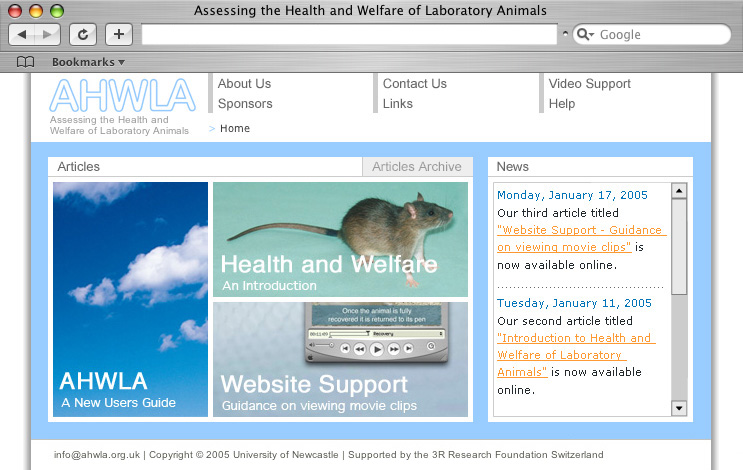 |
de | fr | en Druckansicht ![]()
3R-Project 88-03
Assessing animal health and welfare and recognising pain and distress
Paul Flecknell, Jon Gledhill and Claire Richardson
Medical School, Framlington Place, University of Newcastle upon tyne, NE2 4HH, UK
p.a.flecknell@newcastle.ac.uk
Keywords: rodents; animal welfare; animal health; animal welfare; pain; distress; 3r education; refinement
Duration: 1 year Project Completion: 2006
Background and Aim
We should always aim to minimise any pain or distress that may be experienced by laboratory animals. Considerable progress has been made concerning the application of the principles of reduction and replacement, but implementing refinements require that we improve our ability to recognise signs of pain and distress. If we cannot accurately assess pain or distress, then we cannot determine the significance of a refinement to a research protocol. We also need to be able to recognise, both signs of good health and welfare, and poor welfare, in a wide range of different circumstances, in order that appropriate actions can be taken.
A key issue is the training of new staff so that they can recognise these changes in the animals that they work with. Training courses for new research workers are now well established in many institutions, in many different countries, but delivering effective training requires good quality training material.
Many of those delivering training courses now use computer-based presentations, as this is a very flexible and effective means of providing stimulating and informative seminars. It also provides a very cost-effective means of distributing educational material. We have been developing a range of materials for this purpose (see www.digires.co.uk). We now intend to expand the material that is available and develop a web-based tutorial for use throughout Europe.
Method and Results
The illustrative material needed was obtained from a number of different research institutions and encompasses a wide range of different animal species. The material has been made available in several ways. A web-based tutorial has been produced (AHWLA=Assessing the Health and Welfare of Laboratory Animals), to teach research workers and others to recognise signs of health and good welfare and help them to become better able to identify signs of pain, distress and poor welfare in laboratory animals. The material in these tutorials has also been incorporated into teaching material on the 3Rs Foundation web site and was recognised by the authorities in Switzerland as a continuing education for one day (see Recognising post-operative pain in animals). All of the material on the web tutorials together with additional teaching resources is available for use by lecturers on training courses. The web-based tutorial is now freely available, and additional tutorials will be added over the coming years. Additional material has been distributed free of charge to course tutors in the UK and USA, and will continue to be available for a nominal charge (to cover CD duplication and distribution). The only restriction placed on the use of the material is that incorporation into commercial products requires prior permission and editing of the material for other electronic resources also requires approval. Permission would normally be given to all reasonable requests. When using the material, the support of the Swiss 3Rs Foundation should be acknowledged.
The project provides both still images and video material. Initially a general tutorial designed to assist new research workers in assessing the health and welfare a wide range of species was produced. An introductory tutorial on assessing post-operative pain in animals has now been added. We intend developing the web-site further, to include more detailed tutorials – for example methods of assessing welfare of trasgenic mice, and methods of pain assessment in rodents. We welcome enquiries about the work, and also invite colleagues to contribute material for incorporation on the web site and CD. Appropriate acknowledgement of the source would, of course, be given.
Conclusions and Relevance for 3R
Improving the ability of research workers and other staff involved with animal care to recognise pain and distress,will be a significant step in improving the welfare of large numbers of laboratory animals. This basic training underpins all other attempts at refinement (introduction of improved methods, use of more humane endpoints etc). We believe that providing these resources should be extremely timely, as many European countries are in the process of establishing training courses for new research staff. In addition, those countries which already have training courses will benefit from the enhanced teaching and ease of use that can be provided with these new resources.
Figures

Figure 1: Paul Flecknell
Figure 2
Jon Gledhill
Figure 3
Claire Richardson
Figure 4
http://www.ahwla.org.uk
Web-tutorial 2005 about: Assessing animal health and welfare" and “Recognising post-operative pain in animals – an introduction”

Figure 2

Figure 3

Figure 4
| Letzte Änderung: 12.10.2018 |